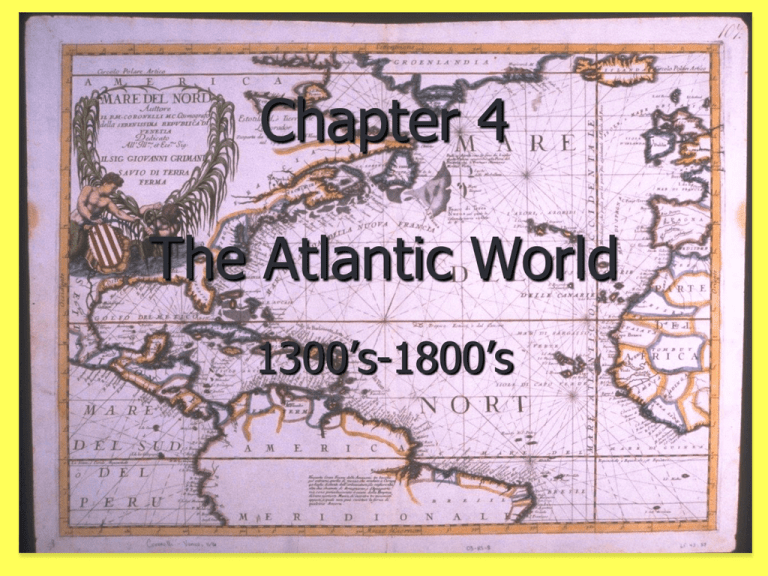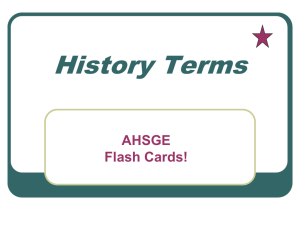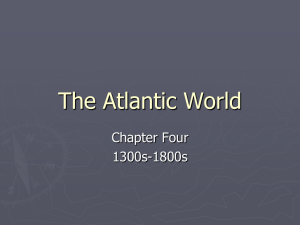Ch 4 Atlantic World and Exploration Powerpoint
advertisement

Chapter 4 The Atlantic World 1300’s-1800’s The Age of Exploration ► Age of Exploration A time period when Europeans began to explore the rest of the world ► Improvements of the time: mapmaking Shipbuilding rigging navigation Made long voyages possible ► Why did European countries explore? New trade routes, New trading partners Mercantilism drives exploration What’s Mercantilism? Power = Wealth! ► Policy that stated there was a limited amount of money in the world ►Gold, silver “To grab what they can before it is gone” Export more than you import = creates a favorable balance of trade! Explorers explored for many reasons ► To find a sea route to the spices of Asia Easier, faster, more goods from one place to another ► Find gold, silver, and precious stones, animal furs greed ► To expand their knowledge of the world Discovery, knowledge ► To control a larger empire power ► To expand Christianity Religious spreading “Gold, God, and Glory!” Vasco de Gama! • from Portugal • Landed in India in 1498 • Established an important trade route from Europe to India and the East Indies Ferdinand Magellan ►1519- convinced King of Spain to fund a voyage to a newly discovered ocean Heard about from another explorertoday’s “Pacific Ocean” ►Sailed southern end of South Americareached Guam ►His crew completed the first circumnavigation of the world in 1525 ►Magellan was killed in the Philippines in a local war Magellan’s Voyage Christopher Columbus ► From Spain- in search for Gold ► Believed he could reach the East Indies faster by traveling west ► found North America instead [Bahamas, Caribbean] and claimed it Spain’s property ► Wanted to turn it into individual colonies: Definition: lands controlled by another nation. He established… The Columbian Exchange! ►A massive exchange of goods, plants, animals and diseases! ►Exchange between New and Old Worlds “Everyone wants a piece of the pie” European countries fought for power, land, resources in the New World France, England, Spain, Portugal Italy: Giovanni da Verrazzano: found N.Y. Harbor when looking for a sea route to the Pacific France: Jacques Cartier: found eat coast of Canada Samuel de Champlain: found Canada’s “New France” (Quebec) area = French colonial empire ► King James’ of England’s explorers: ► founded Jamestown Looking for gold, riches. In first year, many died of starvation Because they were not focusing on farming. Pilgrims and Puritans: founded Plymouth in Massachusetts Came to America for religious freedom From England’s Anglican Church Struggle Turns to Conflict ► England wanted more land: “Hungriest” nation First defeated the Dutch by the Hudson River ► Dispute over lands in the Ohio Valley led to a war in 1754 This began the Seven Years’ War with France ►The battle in the New World was known as the French and Indian War ►British defeat French in 1763 ►Seize eastern half of North America Spanish Conquer! Spanish conquerors= PENINSULARES Spanish men + Native American women= “MESTIZO” population Spanish forced into workfarming, ranched, mined… =ENCOMIENDA - Abolished in 1542 - 1600’s Native American revolts The Conquistadors ► Spain- Explorers- made colonies in regions that today include: Mexico, S. America, U.S. ► Hernan Cortes in Mexico Landed in Aztec Empire “disease of the hart only gold could cure” Aztec believed him- saw him as Godlike because of his armor- gave him gold Able to defeat the mighty Aztec Empire Used superior weapons, allies, and disease 96% Aztec population died from 1500-1620 Francisco Pizzaro ►Defeated the Incan Empire in Peru, S. America ►Ambushed and kidnapped the Incan rulerAtahualpa ►Alahualpa gave gold and silver for release Pizzaro strangled and killed him anyway The Atlantic Slave Trade ► Europeans needed slave labor in their colonies to grow crops, mine, etc. Native Americans were used, but many died due to disease Needed work done on sugar & tobacco farms! Africans replaced the Natives as the main source of slave labor for the Europeans Slavery existed in Africa: - BUT: had rights, social mobility, choices, some had power/authority - Why were African slaves useful in America? 1. 2. 3. 4. 5. Already exposed to European diseasesimmunity Strong, good workers Experienced farming- could be taught Less likely to escape because they didn’t know the terrain Skin made them easier to catch upon escaping The Atlantic Slave Trade Timeline ► 1500-1600s Spain and Portugal began the trade Originally went their for gold but got slaves too ► 1600-1700s Slave Trade grows dramatically ► 1690 England increases the Slave Trade ► 1870 The Atlantic Slave Trade ends ► Begins a system of “Triangular Trade” Africa, Europe, and Americas all participate Middle Passage= Slave’s transportation ► Slave Ships The captain could be a “tight” or “loose” packer ►“Tight” meant slaves would be placed lying on each other ►Typically 20 percent or more Africans would die on the trip ►Disease, malnutrition, beatings, suicide, ► Once in the New World Slaves were auctioned of to the highest bidder The Middle Passage The Middle Passage Atlantic Slave Trade Effects ► African rulers and traders made deals with Europeans for slaves Introduction of guns into African continent Western African economy and empires crumbled Slaves are transported through the “Middle Passage” ►Broke up families ►Lost generation’s fittest members Slavery in the New World ► Slave Resistance Slaves tried to keep their cultural heritage ►Musical stories traditions and Ancestral Lost families, slaves for life, kids were slaves for life… ► Slave Rebellion Often broke tools or worked slowly Many ran away Numerous revolts throughout the years Growth of Global Trade Economic systems of Europe drastically changed ► Colonial empires that stretched through multiple continents led to a new business and trade practices ►Capitalism ►Joint-Stock Companies ► Capitalism is an economic system based on private ownership and the investment of resources, such as money, for profit Economic system where things are owned by people or an individual, not by a government ► Profits allow individuals and businesses to become extremely wealthy, not just the government What is a Joint-Stock Company? ► Like today’s corporations. ► A business in which a number of investors combine their wealth for a common purpose Buy shares of stock in a company! ► Early on in the 1500-1600s the purpose was colonization Overseas colonies were very expensive, but could be very profitable $$$$ = Land Changes in European Society ► Exploration and colonization led to an economic growth and boom in Europe Spurred the growth of towns and cities Rise of the merchant class with great wealth European nations became very wealthy ►Power ► Majority monarchs increased greatly of Europeans still remained poor and rural, however




